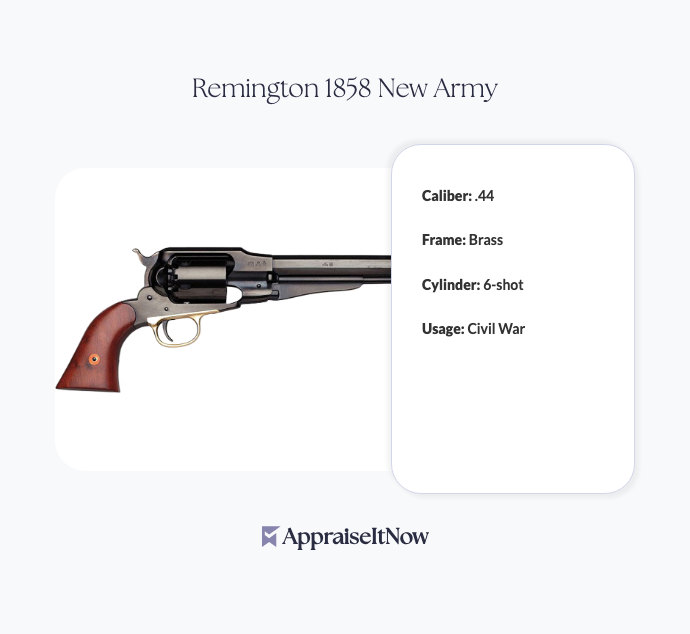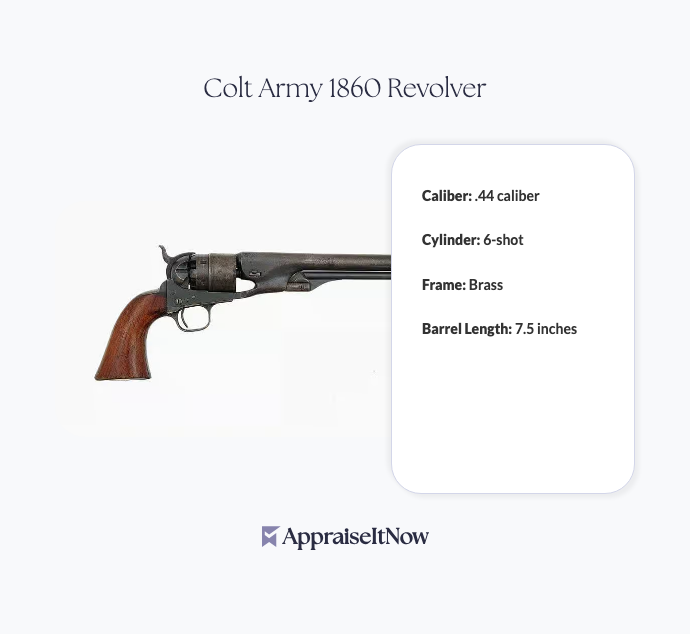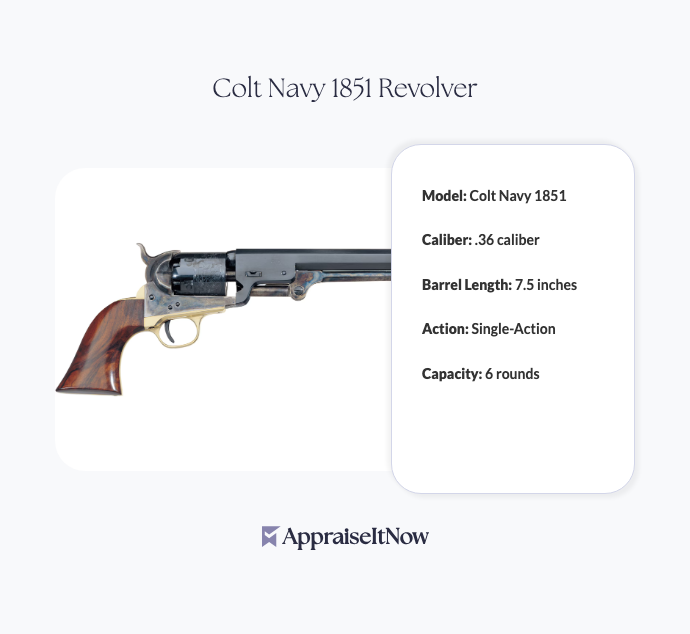<h1>How to Get Your Smith & Wesson Model 1 Revolver Appraised</h1>
<p>The Smith & Wesson Model 1 Revolver stands as a cornerstone of American firearms history, representing the nation's first successful mass-produced handgun. If you own one of these historic pieces, understanding how to properly appraise it will help you make informed decisions about insurance, estate planning, or potential sale. Today's market values these revolvers between <strong>$3,000 and $4,000</strong>, though individual specimens vary significantly based on condition, rarity, and provenance.</p>
<h2>What Makes the Smith & Wesson Model 1 Special</h2>
<p>Your Model 1 Revolver occupies a unique place in <a href="/types/antique-gun">antique gun</a> collecting. Manufactured from 1857 to 1882, this single-action revolver pioneered mass production techniques that shaped American gunmaking for generations. The distinctive spur trigger and rounded, smooth contours remain instantly recognizable to collectors worldwide. With its 6-round cylinder and .22 Short chambering, the Model 1 was designed as a personal defense weapon during an era when technological innovation drove rapid firearm development.</p>
<div class="callout tip"><p><strong>Historical Insight</strong></p>
<p>The Smith & Wesson Model 1 was issued to Union forces during the Civil War, adding significant historical context to documented military examples.</p></div>
<p>The revolver's role in early handgun development cannot be overstated. Before the Model 1, reliable repeating pistols didn't exist in practical form. This innovation earned Smith & Wesson international recognition and established them as industry leaders in precision manufacturing. Understanding this historical significance directly impacts appraisal value, particularly for examples with documented military service or exceptional original condition.</p>
<h2>Key Factors That Influence Your Revolver's Value</h2>
<p>When appraising a Smith & Wesson Model 1, certified appraisers examine specific technical and historical elements. The three distinct issues—1st, 2nd, and 3rd—show measurable value differences in the collector market. A <strong>3rd issue Model 1</strong> typically commands $3,000-$4,000, while earlier production runs may achieve premium pricing.</p>
<p>Condition represents the primary value driver. Original finish integrity, matching serial numbers across frame and cylinder, and bore brightness directly correlate to market price. An example with crisp action, clear markings, and minimal rust or pitting will appraise significantly higher than a piece requiring restoration. Similarly, revolvers retaining original grips and sights demonstrate superior value compared to specimens with period replacements.</p>
<p>Originality matters profoundly to serious collectors of <a href="/types/memorabilia-and-collectibles">memorabilia and collectibles</a>. Examples with factory configuration—including original barrel length, sight configuration, and mechanical specifications—achieve premium valuations. When collectors ask "what are the most collectible Smith and Wesson revolvers?", the Model 1 consistently ranks among top choices due to its scarcity and historical significance, though higher-caliber models sometimes command even greater prices.</p>
<table class='appraisal-table'>
<thead>
<tr>
<th>Production Issue</th>
<th>Years</th>
<th>Notable Features</th>
<th>Typical Value Range</th>
</tr>
</thead>
<tbody>
<tr>
<td>1st Issue</td>
<td>1857-1860</td>
<td>Slightly smaller frame variant</td>
<td>$3,500-$4,500</td>
</tr>
<tr>
<td>2nd Issue</td>
<td>1860-1868</td>
<td>Improved cylinder design</td>
<td>$2,800-$3,500</td>
</tr>
<tr>
<td>3rd Issue</td>
<td>1868-1882</td>
<td>Final production variant</td>
<td>$2,500-$3,500</td>
</tr>
</tbody>
</table>
<h2>Understanding Appraisal Standards for Historic Firearms</h2>
<p>Professional appraisal of your Model 1 Revolver follows established USPAP (Uniform Standards of Professional Appraisal Practice) guidelines ensuring accuracy and legal compliance. Certified appraisers document condition using standardized grading systems, compare recent comparable sales, and research documented provenance to establish fair market value.</p>
<p>The appraisal process differs from casual evaluation or dealer estimates. A thorough professional assessment includes detailed photography of all markings, bore inspection using specialized lighting, mechanical function testing, and comprehensive documentation of any repairs or replacements. This level of detail creates appraisals that hold up in insurance claims, estate proceedings, or litigation scenarios.</p>
<div class="callout note"><p><strong>Certification Matters</strong></p>
<p>Seek appraisers credentialed through organizations like the American Society of Appraisers (ASA), International Society of Appraisers (ISA), or American Society of Arms Collectors (ASAC) to ensure professional expertise.</p></div>
<p>Your appraisal documentation should clearly identify your specific Model 1 variant, note manufacturing date ranges, describe condition with reference photographs, detail any repairs or modifications, and provide comparative market analysis supporting the concluded value. This comprehensive approach protects you whether obtaining coverage quotes from insurance companies or negotiating sale prices.</p>
<h2>Why Professional Appraisal Matters for Historic Revolvers</h2>
<p>Many collectors wonder whether do Smith and Wesson revolvers hold their value? The answer is definitively yes, particularly for first-generation models like your Model 1. Unlike modern production firearms, these antique examples demonstrate consistent appreciation over decades, with values driven by scarcity rather than speculation. However, realizing that appreciation requires proper documentation and informed marketing strategies.</p>
<p>Professional appraisals serve multiple critical purposes beyond simple valuation. They authenticate your revolver's originality, document historical significance, establish insurance replacement cost, support estate distribution decisions, and provide leverage when negotiating with qualified buyers. When considering <a href="/types/memorabilia-and-collectibles">specialty appraisals</a> for collection management, professional documentation becomes invaluable.</p>
<p>Collectors frequently ask "can I tell how old a gun is by the serial number?" The answer involves understanding Smith & Wesson's serial numbering evolution, barrel markings, frame construction details, and manufacturing techniques specific to each production period. Expert appraisers possess this detailed knowledge, interpreting technical markers that distinguish genuine period examples from later modifications or reproductions.</p>
<h2>Comparing Your Model 1 to Other Smith & Wesson Collectibles</h2>
<p>The Model 1's $3,000-$4,000 valuation reflects its historical importance while acknowledging the existence of rarer and more expensive Smith & Wesson revolvers. The Model 629, celebrated in firearms culture, commands different market values depending on production year and configuration. When collectors question "what year was the Smith and Wesson Model 629-1 made?", they're often comparing investment potential across different S&W models, each occupying distinct market niches.</p>
<p>Your Model 1's value proposition differs from later S&W designs. While modern production models appeal to shooters and tactical users, Model 1 revolvers attract serious historians and collectors invested in American industrial heritage. This distinction matters significantly—your revolver's appeal transcends functional firearm characteristics and instead centers on historical artifact qualities. This positioning actually protects long-term value, as it exists outside trends affecting contemporary firearms markets.</p>
<div class="callout tip"><p><strong>Collector's Perspective</strong></p>
<p>Model 1 Revolvers rarely depreciate provided they're properly stored and documented, making them relatively stable investments compared to most collectible assets.</p></div>
<h2>Preservation Strategies to Maintain Appraisal Value</h2>
<p>Protecting your Model 1's condition directly preserves its financial value. Climate-controlled storage at consistent temperature and humidity levels prevents rust formation and material degradation that plague improperly stored firearms. Display cases with inert gas environments or specialized conservation materials offer additional protection for premium examples intended for long-term collection management.</p>
<p>Avoid amateur restoration attempts that compromise originality and reduce appraisal value. Even professional refinishing typically decreases worth for antique examples, as collectors specifically seek original patina and period-appropriate finishes. If your revolver requires conservation attention, engage specialists experienced with antique firearms who understand proper restoration standards that maintain historical integrity while improving condition.</p>
<p>Documentation photography creates essential records for insurance claims and authentication purposes. Capture your Model 1 from multiple angles showing all markings, the action mechanism, cylinder addressing, barrel inscriptions, and grip condition. Maintain these images alongside provenance documentation including bill of sale, inheritance records, or other chain-of-custody evidence that enhances credibility and appraisal value.</p>
<h2>Getting Your Model 1 Revolver Appraised</h2>
<p>The appraisal process begins with selecting an appropriately qualified professional. AppraiseItNow connects you with certified appraisers specializing in <a href="/types/antique-gun">antique guns</a> and historical firearms who understand Model 1 Revolver valuation complexities. Our credentialed experts hold certifications from recognized appraisal organizations and maintain current knowledge of collector market dynamics.</p>
<p>Submit clear photographs and detailed descriptions through our secure online platform. Include any available documentation regarding purchase history, previous appraisals, or known service records. Our appraisers will contact you regarding in-person inspection requirements or handling procedures. For high-value pieces or insurance purposes, professional physical inspection ensures accurate condition assessment that photograph-based evaluation cannot provide.</p>
<p>Professional <a href="/blog/antique-gun-appraisals-what-you-should-know">antique gun appraisals</a> result in formal reports suitable for insurance coverage, estate settlement, donation valuation, or sale preparation. These documents include condition photographs, historical research, comparable sale analysis, and clearly stated fair market value conclusions. The resulting appraisal provides defensible documentation accepted by insurance companies, financial institutions, and legal proceedings.</p>
<h2>Documentation and Legal Considerations</h2>
<p>Unlike modern firearms requiring specific licensing or registration, antique models like your Smith & Wesson Model 1 typically don't trigger federal firearms regulations depending on your jurisdiction. However, specific state and local laws vary considerably. Your certified appraiser can provide guidance regarding legal ownership considerations while remaining focused on valuation methodology.</p>
<p>Comprehensive appraisal documentation creates valuable records for estate planning purposes. If you're considering your collection's future distribution, documented appraisals ensure equitable asset division among heirs. For charitable donations, certified valuations establish tax deduction eligibility while supporting nonprofit documentation requirements.</p>
<div class="callout note"><p><strong>Key Takeaway</strong></p>
<p>Professional appraisal of your Smith & Wesson Model 1 Revolver provides accurate valuation, comprehensive documentation, and peace of mind that your historic firearm is properly valued and protected. Whether preparing for insurance coverage, estate planning, or potential sale, certified appraisers deliver the expertise and credibility that transforms your Model 1 from a family heirloom into a properly documented collectible asset worth $3,000-$4,000 in today's market.</p></div>







.avif)







